Abstract
The government of Nepal has recommended blanket fertilizer application for rice cultivation, which results in lower nutrient use efficiency (NUE) particularly under rainfed conditions. With the aim of finding an appropriate nutrient management practices concerning rice production and profitability, a field experiment was conducted during rainy season of 2017 and 2018 at Kavrepalanchowk and Dang district of Nepal. Altogether, five treatments comprising various nutrient management practices viz. Nutrient Expert Model (NE), use of Leaf Color Chart (LCC), Government Recommended Fertilizer Dose (GON), Farm Yard Manure (FYM), and Farmers’ Field Practice (FFP), were laid out in RCBD with four replications in farmers’ fields. The analysis of variance showed significant difference between treatments for test weight and grain yield in Kavrepalanchowk whereas all traits except number of effective tillers were significant in Dang. The significantly higher grain yield and harvest index were obtained in NE, followed by LCC; and the overall straw yield was highest in LCC, followed by NE in both the locations. Also, yield gap analysis suggested the NE had 44.44% and 23.97% increase in yield as compared to FPP in Kavrepalanchowk and Dang, respectively. The combined analysis with Best Linear Unbiased Estimator revealed the interaction of nutrient management and location significantly effects the straw yield and harvest index across both the locations. The estimated mean straw yield and harvest index were 10.93 t/ha and 34.98%, respectively. Both correlation study and biplot of principal component analysis signaled grain yield had positive correlation with all other traits. Furthermore, the net revenue was maximum for NE, followed by LCC in both the locations. The benefit: cost ratio was highest for NE which was 1.55 in Kavrepalanchowk and 2.61 in Dang. On the basis of these findings, NE and LCC can be effectively used as nutrient management practice by the farmers to obtain maximum production and profitability in Rice.
1. Introduction
Rice (Oryza sativa) is important cereals fulfilling food necessities of more than half of the world’s population [1]. Globally, rice is cultivated over 162.06 million hectares, producing 504.17 million metric tons of milled rice in 2019 [2]. Rice is mainly grown and consumed in Asian countries (China, India, Indonesia, Bangladesh, Vietnam) with 80% of global production [3]. In Nepal, rice is cultivated in 1,458,915-hectare, producing 5,550,878 metric tons of rice, with an average productivity of 3.8 tons/ha during fiscal year 2019–2020 [4]. Nepal’s Gross Domestic Product (GDP) is largely sustained by agriculture, of which rice alone represents 20.75 percent [5]. Nepal’s current rice demand (2512 tons currently) is predicted to double by 2030 (4518 tons) due to population pressure. Further, the study of [6] forecasted that household demand and production would fluctuate from 19% to 80% by 2030. It is necessary to increase rice production and productivity to close the gap in supply and demand with the limited resource available, owing to the unstable rice yield due to insect, pest, nematodes, declination of soil fertility, imbalanced fertilizer use and poor nutrient management practices [7,8].
In Nepal, rice is grown with urea as the primary nitrogen source, but plants utilize only 30% of the applied urea, whereas the rest 70% is lost due to NH3 volatilization, surface runoff and leaching in lowland rice therefore, rice farmers need to maximize nitrogen use efficiency (NUE) while maintaining low nitrogen inputs [9,10]. Concept of Site-Specific Nutrient Management (SSNM) was developed to apply nutrients at the optimal rates with maximum nutrient use efficiency [11]. SSNM is a component of precision agriculture as it combines the nutrient requirements of plants at various growth stages with the soil’s ability to supplying them. Further, SSNM integrates with Nutrient Expert; computer-based tool to estimate fertilizer requirement considering nutrient use efficiency, estimated yield, along with nutrient balance and added nutrients effect on yield [12]. SSNM principles recommend fertilizer based on the 4’R’-right dose, right method, right source, and right timing [13].
There have been different trails deploying Nutrient Expert in wheat and maize [14], in wheat [15] and in Rice [16]. These studies have demonstrated the significance of nutrient experts’ recommendations over practices adapted by farmers concerning yield and profitability. The amount of fertilizer required for a field is calculated from the predicted yield in response to every fertilizer nutrient which is the contrast between the attainable yield and the nutrient-limited yield. Further, Nutrient osmosis trials are performed in farmer’s fields to determine the attainable yield Attainable yield is the yield of particular without any nutrient limitation under best management practice in the farmer’s location [17].
Government of Nepal’s fertilizer dose recommendations are based on the fertility status of particular region in Nepal, rather than the soil fertility of the individual farmer. This leads to a need for SSNM techniques such as Leaf color chart (LCC) due to the lack of adequate dissemination of the developed approach. Thus, this research aims to evaluate the production and profitability of hybrid rice through different nutrient management practices at two locations; and to analyze the traits associated with higher yield.
2. Materials and Methods
2.1. Study Site and Weather Conditions
A field experiment was conducted in farmers’ field of Mahadevsthan of Kavrepalanchok (Kavre) during rainy season of 2017 and in Lamahi municipality, Dang district during the rainy season of 2018. The site of Kavre is at 27°71′ North latitude and 85°61′ East longitudes which is 670 m above MSL. The site of Dang is at 27.8771° N, 82.5727° E, with 250 above meter sea level. An experimental site is located in a dry rain-fed region of Nepal with a subtropical climate consisting of wet summers and dry winters. The weather of the research area is presented in Figure 1.
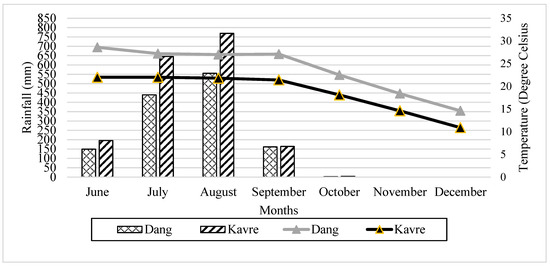
Figure 1.
Climatic data of Research area.
2.2. Experimental Setup and Crop Management
A field experiment was conducted in Kavre and Dang districts of Nepal during the kharif seasons of 2017 and 2018 with hybrid rice transplanted to the main field after 22 days in the nursery bed as per farmer’s practice. The details of soil chemical properties are given on Table 1. Experimental treatments were laid out on Randomized Complete Block Design with four replications in both locations. Seedlings were transplanted one per hill with a spacing of 25 cm × 25 cm i.e., the seed rate was 10 kg/ha. Each plot was fertilized according to the treatment (nutrient management practice) assigned to it in Table 2.

Table 1.
Soil chemical properties of research area.

Table 2.
Treatment details for the experiment in both Kavre and Dang.
Three fertilizers named as Urea (46% N), Diammonium phosphate (18% N and 46% P2O5) and Muriate of Potash (60% K2O) were used as a source of Nitrogen, Phosphorus and Potassium as per guidelines of Government of Nepal. In the Nutrient Expert (NE), fertilizer dose along with the application time as per the recommendation of NE model was applied. The model was run with the data of surveyed (interviewed farmer with questionnaire). In the Leaf Color Chart (LCC), P & K was applied as per the recommendation made by NE and N was applied as per need on the basis of Leaf Color Chart (LCC) score. In the Government of Nepal recommended fertilizer dose (GON), fertilizer in each plot was applied as per the recommendation by National Agriculture Research Council (NARC); 140:60:30 kg NPK ha−1 [18]. In the Farmyard Manure (FYM), FYM was applied to each field at 15-ton ha−1.
2.3. Measurement and Data Collection
The agro-morphological traits such as plant height, number of effective tillers per meter square, length of panicle, test weight, straw and grain yield were recorded. The total cost and gross revenue of the rice production was calculated. The harvest index and fertility were taken and economic parameters (B:C ratio) were evaluated by using following formulae:
a. Fertility: Fertility was calculated as per [19] i.e.,
Fertility% = (number of fertile grains/total number of florets) × 100
b. Harvest Index: Harvest index (HI) was computed by
H.I.% = (grain yield/(grain yield + straw yield) × 100
c. Benefit cost (B:C) ratio was calculated by using gross return and cost of cultivation [20]; Benefit: cost ratio = Net return/cost of cultivation
2.4. Data Analysis
MS Excel was used to enter and process all the data. An analysis of variance (ANOVA) was carried out using R version 3.6.0. R package-Agricoale to test for significant difference between treatment means at the 0.05 level of significance. The combined analysis of two sites was carried out by Meta-R with the Best Linear Unbiased Estimator (BLUE). MINITAB 14.0 was used to prepare the principal component biplot.
3. Results and Discussion
3.1. Result of Mean Performance of Rice Traits
3.1.1. Plant Height (PH)
An analysis of variance revealed a highly significant difference (p < 0.01) between the treatments for plants in Dang, but while in Kavre difference was not significant statistically (Figure 2). The overall mean of the plant height was 91.63 cm. The mean plant height was 87.47 cm and 95.78 cm in Kavre and Dang, respectively. Plant height was maximum in FYM (91.58 cm) and minimum in NE (83.76 cm) at Kavre while at Dang maximum plant height was observed in NE (99.89 cm), followed by GON (98.41 cm) and minimum plant height was observed in FFP (88.39), respectively). These findings are supported by report of [21].
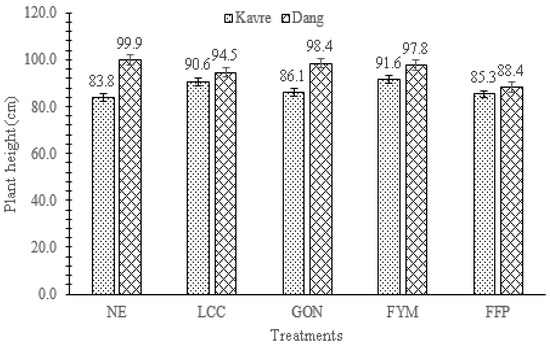
Figure 2.
Effect of nutrient management practices on Plant Height of Rice at Kavrepalanchowk and Dang.
3.1.2. Number of Effective Tiller (NOET)
A significant difference (p < 0.05) was found for the number of effective tillers per m2 at Kavre, while it was not significant at Dang (Figure 3). The mean number of tillers per m2 was 258, 363, and 315.50 in Kavre, Dang and the overall field, respectively. The number of effective tillers per m2 was highest in GON plots (278.40) followed by LCC (273.00) and minimum in FFP plots (224.80) in Kavre while LCC had the maximum number of effective tillers per m2 (387.65) and NE had the lowest number of effective tillers per m2 (355.20) at harvest in Dang.
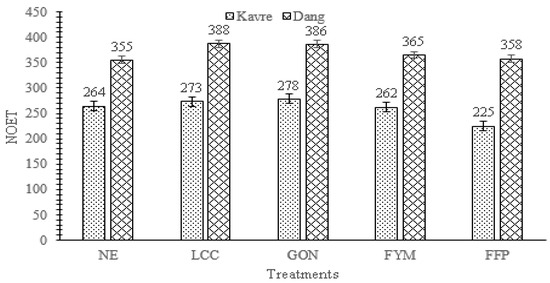
Figure 3.
Effect of nutrient management practices on Number of Effective Tillers per Square Meter of Rice at Kavrepalanchowk and Dang.
3.2. Panicle Length (PL)
Panicle length was statistically significant (p < 0.01) in Dang while non-significant in Kavre (Figure 4). The overall mean of the panicle length was 24.76 cm. Kavre and Dang had mean panicle lengths of 26.92 cm and 22.59 cm, respectively.
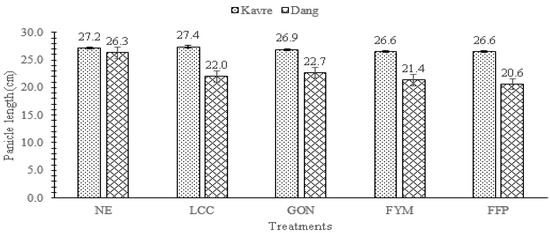
Figure 4.
Effect of nutrient management practices on Panicle Length of rice at Kavrepalanchowk and Dang.
3.3. Kavre
LCC had the longest panicle length (27.41 cm), followed by NE (27.18 cm), and FYM and FPP both had the shortest panicles (26.56 cm). These result are in line with result obtained by [22].
3.4. Dang
The longest panicle length was found in NE (26.31 cm) which was statically superior to all other treatments. The shortest panicle was found in FPP (20.61 cm) which was statistically at par with LCC, GON, and FYM. Similar result was obtained by [23].
3.5. Fertility (FT)
In Kavre, there was no significant difference between treatments in regards to percentage fertility, while in Dang, there was significant difference (Figure 5). The overall mean of the fertility was 77.40%. The mean percentage of fertility in Kavre and Dang were 72.6% and 82.2%, respectively. The percentage of fertility ranged from 68.5% to 80.25% with highest fertility recorded in LCC and lowest fertility recorded in FYM in Kavre. In dang, the percentage of fertility ranged from 67.24% to 90.52%. The highest fertility recorded in FYM was statistically superior to other treatments. It was followed by LCC (88.12%) and NE (87.56%). The lowest fertility recorded in FPP.
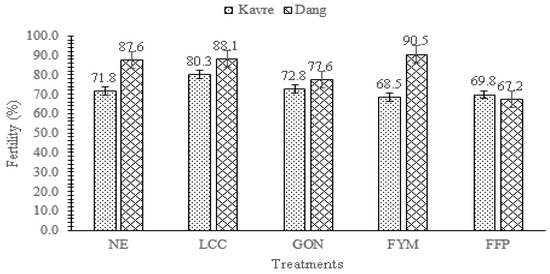
Figure 5.
Effect of nutrient management practices on Fertility of rice at Kavrepalanchowk and Dang.
3.6. Test Weight
The ANOVA showed significant effects (p < 0.01) of treatments on test weight of rice in both Kavre and Dang (Figure 6). The mean thousand grain weight was 15.7 g in Kavre and was 15.75 g in Dang. The overall mean was 15.73 g.
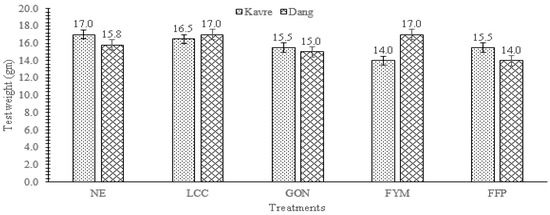
Figure 6.
Effect of nutrient management practices on test weight of rice at Kavrepalanchowk and Dang.
In Kavre, the maximum test weight recorded was 17.0 g in NE which was followed by LCC (16.5 g). While, the minimum test weight recorded was 14.0 g in FYM. Similarly, in Dang, the maximum test weight recorded was 17.00 g in FYM and LCC. While, the minimum test weight recorded was 14.0 g in FPP.
3.7. Grain Yield
3.7.1. Kavrepalanchowk
The ANOVA elucidated significant effects of treatments on grain yield of rice at 0.05 level of significance (Figure 7). The highest grain yield (5.84 t/ha) was recorded in NE management followed by LCC (5.61 t/ha), GON (5.34 t/ha) and FYM (5.14 t/ha). The lowest yield (4.10 t/ha) was obtained in FYM.
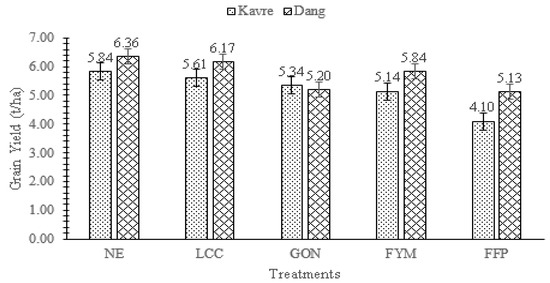
Figure 7.
Effect of nutrient management practices on grain yield of rice at Kavrepalanchowk and Dang.
3.7.2. Dang
The ANOVA elucidated treatments caused significant variation on the grain yield of rice at 0.01 level of significance. The highest grain yield of rice (6.36 t/ha) was recorded in NE in NE management followed by LCC (6.17 t/ha), and FYM (5.8004 t/ha). The lowest yield (5.13 t/ha and 5.20 t/ha) was obtained in FPP and GON, statically at par with FYM.
3.8. Straw Yield
There was significant difference between nutrient management treatments for straw yield in Kavre and Dang (Figure 8). The mean straw yield in Kavre was 10.9 t/ha and in Dang was 10.97 t/ha. The overall mean was found to be 10.93 t/ha. The highest straw yield was 12.04 t/ha in FFP, followed by 11.50 t/ha in GON statistically at par with FFP while the lowest yield was found in LCC (9.50 t/ha) in Kavre. In Dang, the highest straw yield was found in LCC (12.87 t/ha) statistically at par with NE (12.62 t/ha). The lowest straw yield was found in FFP (12.04 t/ha).
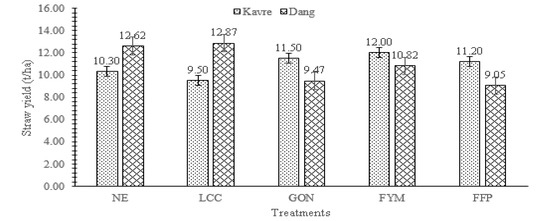
Figure 8.
Effect of nutrient management practices on straw yield of rice at Kavrepalanchowk and Dang.
3.9. Harvest Index
The harvest index between treatments differed significantly in Dang while it did not differ significantly in Kavre (Figure 9). The mean harvest index was 33.92% and 35.76% in Kavre and Dang, respectively.
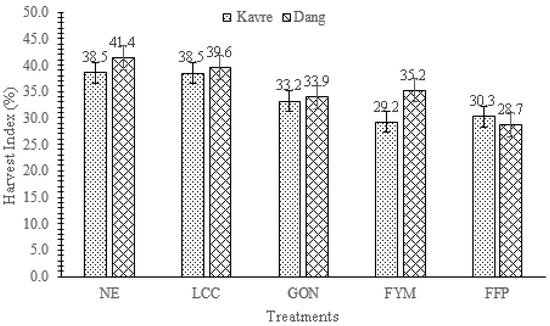
Figure 9.
Effect of nutrient management practices on harvest index of rice at Kavrepalanchowk and Dang.
3.9.1. Kavrepalanchowk
In terms of harvest index, NE had the highest harvest index with 38.52%, followed by LCC with 38.47%. The lowest harvest index was found in FYM (29.20%). Ref. [24] reported NE in wheat produces 38% higher harvest index than FFP, which is consistent with our findings.
3.9.2. Dang
Significantly higher harvest index was obtained from NE fertilizer recommendation (41.38%) than other treatments, followed by LCC (39.57%) which are statistically at par. The lowest harvest index found was 28.73% in FYM.
4. Discussion on Mean Performance of Rice Traits
This research was similar to one by [25]. where balanced use of fertilizer boosted plant growth and produced maximum height, whereas poorly fertilized plots produced plants with minimal height. The application of macronutrients according to site requirements leads to higher plant heights in rice [26,27]. Further, this finding is in line with [28], who reported SSNM had more effective tillers than FFP. Optimal fertilizer application leads to higher tiller productivity per area when nutrient-balanced fertilizers are used [29,30,31] mention a similar pattern of straw yield under different nutrient management. The reason for high straw yield in LCC and NE because of balance nitrogen applied that influenced the vegetative growth, plant height and number of tillers leading to a high straw yield.
The nutritional management practices in Kavre and Dang differed significantly in terms of grain yield. A higher yield was recorded in NE, while a lower yield was recorded in FFP. This finding is in line with [32], they performed fifty six on-farm researches in rice and found out SSNM yielded 17% higher than FFP. In addition, they mention SSNM yield is higher than average yield for all other nutrient managements. The evidence of NE superior to over government recommendations or existing practices is reported by [13] using NE for maize and wheat. Hence, NE is far better nutrient management practice over GON and FFP [33]. Further, the authors claimed that rice managed under NE performs better than rice managed under FFP and GON due to the balanced and right source of fertilizer applied at the right time.
The grain yield is a complex trait attributed by different components. Ref. [34] found that higher yield in NE is the result of better panicle length, number of effective tillers per square meter, and test weight, which also result in higher harvest index and 30% less fertilizer use. Similar to this research, lowest HI in FFP and highest HI in NE is reported by [14,35].
The research of [15] also shows that under NE there is 38% more HI. Likewise, Ref. [32] found a trend in HI that is consistent with the results of this study.
4.1. Combined Analysis of Straw Yield and Harvest Index in Kavre and Dang
The Nutrient management and Location Interaction showed significant effect in the combined straw yield and harvest index across both the locations while treatment effect was found to be statistically non-significant as presented in Table 3. These findings suggest that combine performance of the nutrient management for biological yield is influenced by the environment of the location. This implies that combined straw yield and harvest index across both locations are determined by the interaction effect and are not influenced by nutrient management alone.

Table 3.
Combined Statistics (ANOVA) of Straw Yield and Harvest Index with Best Linear Unbaised Estimator (BLUE) across both the location.
The mean of the overall straw yield estimated across both the environment was 10.93 t/ha. In terms of straw yield, the highest yield was given by NE (11.45 t/ha) and the lowest yield by GON (10.26 t/ha). The mean of overall straw yield estimated across each environment was found to be 34.98%. The maximum harvest index has been found in GON (37.67%) and the minimum harvest index has been found in FYM (31.14%).
4.2. Yield Gap Analysis
4.2.1. Yield Gap at Kavre
In comparison with FFP, yields from NE increased by 42.44%, followed by LCC and GON by 36.82% and 30.24%, respectively (Table 4). Similar result of grain yield increased by 37.62% in NE-Rice recommendation over the FFP [36]. These results are in agreement with [15] in wheat reported NE produced 57% more grain yield than FFP. This implies that in contrast with FFP, different treatments showed increased grain yield.

Table 4.
Increment on grain yield of hybrid rice over Farmer fertilizer practice through different nutrient management practices in Kavre and Dang.
4.2.2. Yield Gap at Dang
The study showed that NE based nutrient management can produce 1.23 tons ha−1 more grain yield than the existing FFP, which is 23.97% higher (Table 5). Additionally, LCC and GON yielded 20.27% and 1.36%, respectively. Shrestha et al. (2018) reported similar results for the Dang condition.

Table 5.
Correlation between different traits of rice in both the locations.
4.3. Correlation among Different Rice Trait across Both the Location
The correlation coefficient between different Rice trait and harvested index is presented in Table 5. The grain yield had significant strong positive correlation with Fertility (0.90), Test Weight (0.93), Straw Yield (0.89), and Harvest Index (0.94). There was significant strong positive correlation of Harvest Index with Test Weight (0.95) and Grain Yield. Further, the correlation between Test Weight, Fertility and Grain Yield was significant. [37] support the significant positive correlation between GY and NOET, PL, and SY. Positive correlation between GY and PL is in line with results of [38,39,40]; while positive correlation with NOET was supported by finding of by [41,42]. Moreover, [43] reported significant positive association between GY and NOET, TW. Similarly, positive correlation of GY with TW and PL was found in [44]. Ref. [45] also reported a positive relation of plant height and number of tillers per plant with grain yield of rice.
4.4. Principal Component Analysis of Different Rice Traits
The correlation presented the relation among the tested variable. The PCA was performed with the view to clarify the relation and present the variation explained by each trait.
4.5. Eigen Value and Principal Component
The first four principal components explained 100% of the existing variation in which principal component 1 (PC1), PC2, PC3 and PC4 explained 72.2%, 15%, 0.81%, and 0.47% of the variation, respectively (Table 6).

Table 6.
Eigen value and Principal Component of different Rice traits.
A positive correlation exists between all tested traits and PC1, and Grain Yield (0.411) is the main contributor to variability.PC2 was positively affected by Panicle Length, Test Weight, Harvest Index, and Grain Yield. Panicle length (0.533) was the major contributor toPC2. PC3 was positively influenced by Number of Effective Tillers, Panicle length, and Test Weight. The major contributing trait was the Number of Effective Tillers (0.679). PC4 was positive correlated with Fertility, Test Weight, and Harvest Index with Test weight (0.518) contributing the highest.
4.6. Biplot of PCA
The biplot of PCA was prepared to identify the trend of traits for main source of variation under both the location. The biplot component accounted 87.2%, PC1 (72.2%) and PC2 (15%), of the variability for the traits (Figure 10).
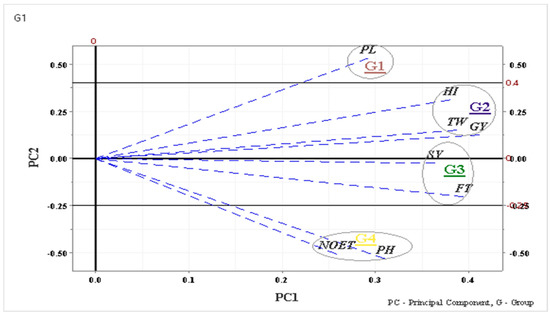
Figure 10.
Loading biplot of different Rice traits in both the locations.
The biplot showed PC2 is able to separate the traits. The traits were grouped in four Groups (G). The Group 1 had low positive value of PC1 and high positive value of PC2; and consist of PL only. The Group 2 had high positive value of PC1 and low positive value of PC2 which comprises of TW, GY, and HI. The Group 3 had high positive value PC1 and low negative value of PC2; and consist of SY and FT. Finally, the Group 4 had low positive value of PC1 and high negative value of PC2 which comprises of NOET and PH.
The biplot shows that PC2 separates G1 from G2, G2 from G3 and G3 from G4. Also, PC1 separates G1 and G4 from G2 and G4. The traits in the G2 and G3 had the higher variance than the G1 and G4. Furthermore, GY had the highest variance and NOET had the lowest variance, among all the traits.
The vector angle of the traits has acute angle with each other revealed that each trait are positively correlated with another trait. Among the traits, within G2 (TW, GY and HI) have very small angles so, are strongly correlated to each other. Similarly, traits in G3 (SY and FT), traits in G4 (NOET and PH) are also strongly correlated. The traits in G1 (PL) have low positive correlation with traits in G4 (NOET and PH) because they have large acute angle between their vectors.
Correlation only shows strength of relationship between yield and other traits [46] while PCA is useful of identification of traits of high variability which helps in improvement of grain yield [47]. The similar analysis of different Rice trait with the help of PCA and biplot is observed in the report of [48] and [49]. Ref. [50] reported 65.4% of the total variation was because of first five principal components. This finding is in line with [51,52] and our finding.
4.7. Production Economics at Kavre and Dang
Significant result among the treatments was obtained for calculated economics of production viz. gross revenue, net revenue and benefit: cost ratio of rice production in Kavre and Dang (Table 7).

Table 7.
Gross return, net return and B: C ratio of rice influenced by nutrient management practices in Kavrepalanchowk and Dang.
4.7.1. Kavre
The mean gross revenue and net revenue of all the nutrient management practices were 151,099 NRs/ha and 23,635 NRs/ha, respectively.
The highest gross revenue was obtained in NE (182,710 NRs/ha) which is followed by LCC (64,516 NRs/ha). The high gross revenue in NE can be attributed to its high grain and straw yield.
Similarly, the net revenue was found higher in NE (64,516 NRs/ha) followed by LCC (42,543 NRs ha−1). The lowest net revenue was found in FYM (−12,869 NRs/ha). Ref. [53] mentioned in their reported that NE tools enables farmer to gain higher profits over the traditional fertilizer use practices.
Furthermore, NE (1.545) recorded the highest B:C ratio followed by LCC (1.356) and then FFP (0.879) with all three statistically at par. While lowest B:C ratio was recorded in FYM (0.879). This higher B:C ratio in NE treatments maybe because of N saving and increased yield of crop which ultimately increased gross and net return and reduced production cost. Ref. [54] reported the reduction of production cost with site specific nutrient management which agrees to findings of present research.
4.7.2. Dang
The highest gross revenue was obtained in NE (206,211 NRs/ha) which is followed by LCC (177,761 NRs/ha) and GON (173,289 NRs/ha). The lowest gross revenue is obtained in FFP (151,395 NRs/ha).
Similarly, the net revenue was found higher in NE (75,925 NRs/ha) which was statistically at par with LCC (62,302 NRs ha−1).
Furthermore, NE (2.61) recorded the highest B:C ratio followed by LCC and FFP both with 1.356 B:C ratio and then GON (2.02) was the lowest B:C ratio recorded.
5. Conclusions
Nepal’s rice production is much below its potential due to farmers’ imbalanced fertilizer application practices. The proper nutrient management, i.e., the correct amount and timing of fertilizer application, minimizes the yield gap in crops.NE and LCC have both been proven effective in increasing grain and straw yield. Furthermore, the highest benefit-cost ratio for the Rice production was achieved in NE due to its high net revenue for farmers. According to BLUE estimates, the straw yield and harvest index were both affected by nutrient management and location interaction. Furthermore, all the tested traits were found positively correlated with the grain yield of Rice. This experiment concluded that nutrient management practices (Nutrient expert and Leaf Color Chart) are most appropriate for increasing the profitability of farms producing rice.
Author Contributions
Conceptualization, K.G., K.R.D. and L.P.A.; methodology, R.D.B., S.P. (Samiksha Pokhrel), M.P. (Mahendra Paudel), S.A. and B.P.K.; software, K.A., B.K.C., M.P. (Meena Pandey) and Y.K.; validation, S.P. (Samrat Paudel), M.S. and B.R.P.; formal analysis, T.R.B., N.K. and S.M.A.; investigation, S.P. (Samiksha Pokhrel) and M.S.; resources, M.M.S.; data curation, G.E.-S.B.; writing—original draft preparation, R.D.B. and J.U.; visualization, S.P. (Samiksha Paudel); supervision, J.U.; advisor, N.K.; funding acquisition, S.M.A. and M.M.S. All authors have read and agreed to the published version of the manuscript.
Funding
This study was supported by the Taif University Researchers Supporting Project (TURSP-2020/105), Taif University, Taif, Saudi Arabia.
Acknowledgments
We appreciate and thank Taif University for the financial support for Taif University Researchers Supporting Project (TURSP-2020/105), Taif University, Taif, Saudi Arabia.
Conflicts of Interest
The authors declare no conflict of interest.
References
- Maiti, R.; Sarkar, N.C.; Rodriguez, H.G.; Kumari, A.; Begum, S.; Rajkumar, D. Advances in Rice Science: Botany, Production, and Crop Improvement; Apple Academic Press: Palm Bay, FL, USA, 2020. [Google Scholar]
- Shahbandeh, M. World Production Volume of Milled Rice from 2008/2009 to 2020/2021. 2021. Available online: https://www.statista.com/statistics/271972/world-husked-rice-production-volume-since-2008/ (accessed on 9 June 2021).
- Abdullah, A.; Kobayashi, H.; Matsumura, I.; Ito, S. World Rice Demand towards 2050: Impact of Decreasing Demand of Per Capita Rice Consumption for China and India. 2008. Available online: https://www.semanticscholar.org/paper/World-Rice-Demand-Towards-2050%3A-Impact-of-Demand-of-Ito/260f4d3b195718591a8143982ec4cffa66f8f338 (accessed on 9 June 2021).
- MoALD. Selected Indicators of Nepalese Agriculture. Available online: https://nepalindata.com/ (accessed on 9 June 2021).
- ABPSD. Statistical Information on Nepalese Agriculture 2013/14 (2070/071), Agri Statistics Section, Agri Business Promotion and Statistics Division; Government of Nepal; Ministry of Agriculture and Co-Operatives; ABPSD: Kathmandu, Nepal, 2014. [Google Scholar]
- Prasad, K.; Singh, R.; Singh, S. Effect of seedlings age and number of seedlings per hill on the yield of rice in a sodic soil. Curr. Agric. 2011, 16, 67–70. [Google Scholar]
- Katoch, P.; Katoch, A.; Podel, M.; Uperti, S. Bakanae of Rice: A serious disease in Punjab. Int. J. Curr. Microbiol. Appl. Sci. 2019, 8, 129–136. [Google Scholar] [CrossRef]
- Baral, B.R.; Pande, K.R.; Gaihre, Y.K.; Baral, K.R.; Sah, S.K.; Thapa, Y.B. Farmers’ fertilizer application gap in rice-based cropping system: A case study of Nepal. SAARC J. Agric. 2019, 17, 267–277. [Google Scholar] [CrossRef]
- Matsushima, S. High Yielding Rice Cultivation; University of Tokyo Press: Tokyo, Japan, 1976. [Google Scholar]
- Ladha, J.K.; Pathak, H.; Krupnik, T.J.J.; Six, J.; Van Kessel, C. Efficiency of fertilizer nitrogen in cereal production: Retrospects and prospects. Adv. Agron. 2005, 87, 85–156. [Google Scholar]
- Joshy, D. Soil Fertility and Fertilizer Use in Nepal. 1997. Available online: https://agris.fao.org/agris-search/search.do?recordID=NP9700156 (accessed on 9 June 2021).
- Witt, C.; Buresh, R.J.; Peng, S.; Balasubramanian, V.; Dobermann, A. Nutrient management. In Rice A Practical Guide to Nutrient Management; Fairhurst, T.H., Witt, C., Buresh, R., Dobermann, A., Eds.; International Rice Research Institute: Los Baños, Philippines, 2007. [Google Scholar]
- Satyanarayana, T.; Majumdar, K.; Pampolino, M.; Johnston, A.M.; Jat, M.L.; Kuchanur, P.; Sreelatha, D.; Sekhar, J.C.; Kumar, Y.; Maheswaran, R.; et al. Nutrient Expert TM: A Tool to Optimize Nutrient Use and Improve Productivity of Maize. Better Crop. 2013, 97, 21–24. [Google Scholar]
- Dahal, S.; Shrestha, A.; Dahal, S.; Amgain, L.P. Nutrient Expert Impact on Yield and Economic In Maize and Wheat. Int. J. Appl. Sci. Biotechnol. 2018, 6, 45–52. [Google Scholar] [CrossRef][Green Version]
- Bhatta, R.D.; Amgain, L.P.; Subedi, R.; Kandel, B.P. Assessment of productivity and profitabilty of wheat using Nutrient Expert®-Wheat model in Jhapa district of Nepal. Heliyon 2020, 6, e04144. [Google Scholar] [CrossRef]
- Amgain, L.P.; Timsina, J.; Dutta, S.; Majumdar, K. Nutrient expert® rice—An alternative fertilizer recommendation strategy to improve productivity, profitability and nutrient use efficiency of rice in Nepal. J. Plant Nutr. 2021, 44, 2258–2273. [Google Scholar] [CrossRef]
- Sapkota, T.B.; Majumdar, K.; Jat, M.L.; Kumar, A.; Bishnoi, D.K.; McDonald, A.J.; Pampolino, M. Precision nutrient management in conservation agriculture based wheat production of Northwest India: Profitability, nutrient use efficiency and environmental footprint. Field Crop. Res. 2014, 155, 233–244. [Google Scholar] [CrossRef]
- Shah, M.L.; Yadav, R. Response of Rice Varieties to Age of Seedlings and Transplanting Dates. Nepal Agric. Res. J. 2001, 4–5, 14–17. [Google Scholar] [CrossRef]
- Prasad, R.; Shivay, Y.S.; Kumar, D.; Sharma, S.N. Learning by Doing Exercises in Soil Fertility (A Practical Manual for Soil Fertility); Division of Agronomy, IARI: New Delhi, Indian, 2006. [Google Scholar]
- Pal, S.; Sana, M.; Banerjee, H.; Lhungdim, L. Effectiveness of nitrogen and bio-fertilizer choice for improving growth and yield of hybrid rice (Oryza sativa L.) during dry season. Oryza-An Int. J. Rice 2020, 57, 302–309. [Google Scholar] [CrossRef]
- Meena, S.L.; Singh, S.; Shivay, Y.S. Response of hybrid rice (Oryza sativa) to nitrogen and potassium application in sandy clay-loam soils. Indian J. Agric. Sci. 2003, 73, 8–11. [Google Scholar]
- Aslam, M.M.; Zeeshan, M.; Irum, A.; Hassan, M.U.; Ali, S.; Hussain, R.; Ramzani, P.M.A.; Rashid, M.F. Influence of Seedling Age and Nitrogen Rates on Productivity of Rice (Oryza sativa L.): A Review. Am. J. Plant Sci. 2015, 6, 1361–1369. [Google Scholar] [CrossRef]
- Subedi, R. Nursery Management Influences Yield and Yield Attributes of Rainfed Lowland Rice. J. Sustain. Soc. 2013, 2, 86–91. [Google Scholar] [CrossRef]
- Dutta, S.K.; Majumdar, K.; Satyanarayana, T. India, Nutrient Expert: A precisionnutrient management tool for smallholder production systems of India. Crop Soils Mag. 2014, 47, 23–25. [Google Scholar] [CrossRef]
- Malghani, A.L.; Malik, A.U.; Sattar, A.; Hussain, F.; Abbas, G.; Hussain, J. Response of Growth and Yield of Wheat to NPK fertilizer. Sci. Int. 2010, 24, 185–189. [Google Scholar]
- Budhathoki, S.; Amgain, L.P.; Subedi, S.; Iqbal, M.; Shrestha, N.; Aryal, S. Assessing Growth, Productivity and Profitability of Drought Tolerant Rice Using Nutrient Expert—Rice and Other Precision Fertilizer Management Practices in Lamjung, Nepal. Acta Sci. Agric. 2018, 2, 153–158. [Google Scholar] [CrossRef]
- Chaturvedi, I. Effect of Nitrogen Fertilizers on Growth, Yield and Quality of Hybrid Rice (Oryza sativa). J. Cent. Eur. Agric. 2005, 6, 611–618. [Google Scholar] [CrossRef]
- Marahatta, S. Increasing productivity of an intensive rice based system through site specific nutrient management in Western Terai of Nepal. J. Agric. Environ. 2017, 18, 140–150. [Google Scholar] [CrossRef]
- Haq, M.T.; Sattar, M.A.; Hossain, M.M.; Hasan, M.M. Effects of Fertilizers and Pesticides on Growth and Yield of Rice. J. Biol. 2002, 2, 84–88. [Google Scholar] [CrossRef]
- Hussain, N.; Khan, M.A.; Javed, M.A. Effect of foliar application of plant micronutrient mixture on growth and yield of wheat (Triticum aestivum). Pakitstan J. Biol. Sci. 2005, 8, 1096–1099. [Google Scholar] [CrossRef]
- Virmani, S.S.; Mao, C.X.; Hardy, B. Hybrid Rice for Food Security, Poverty Alleviation, and Environmental Protection; International Rice Research Institute: Metro Manila, Philippines, 2003. [Google Scholar]
- Dobermann, A.; Witt, C.; Dawe, D.; Abdulrachman, S.; Gines, H.; Nagarajan, R.; Satawathananont, S.; Son, T.; Tan, P.; Wang, G.; et al. Site-specific nutrient management for intensive rice cropping systems in Asia. Field Crop. Res. 2002, 74, 37–66. [Google Scholar] [CrossRef]
- Gaire, A.; Koirala, S.; Shrestha, R.K.; Amgain, L.P. Growth and Productivity of Different Cultivars of Rice Under Nutrient Expert© and Other Fertilizer Management Practices at Lamjung. Int. J. Appl. Sci. Biotechnol. 2016, 4, 178–182. [Google Scholar] [CrossRef][Green Version]
- Wang, G.; Zhang, Q.C.; Witt, C.; Buresh, R.J. Opportunities for yield increases and environmental benefits through site-specific nutrient management in rice systems of Zhejiang province, China. Agric. Syst. 2007, 94, 801–806. [Google Scholar] [CrossRef]
- Biradar, D.; Aladakatti, Y.; Rao, T.; Tiwari, K. Site-specific nutrient management for maximization of crop yields in Northern Karnataka. Better Crop. 2006, 90, 33–35. [Google Scholar]
- Shrestha, S.; Amgain, L.P.; Subedi, R.; Shrestha, P.; Shahi, S. Productivity and Profitability Analysis of Old Aged Hybrid Rice Seedling Using Nutrient-Rice Expert and Other Precision Nutrient Management Practices at Lamjung, Nepal. Int. J. Appl. Sci. Biotechnol. 2018, 6, 232–237. [Google Scholar] [CrossRef]
- Adhikari, B.N.; Joshi, B.P.; Shrestha, J.; Bhatta, N.R. Genetic variability, heritability, genetic advance and correlation among yield and yield components of rice (Oryza sativa L.). J. Agric. Nat. Resour. 2018, 1, 149–160. [Google Scholar] [CrossRef]
- Aditya, J.P.; Bhartiya, A. Genetic variability, correlation and path analysis for quantitative characters in rainfed upland rice of Uttarakhand Hills. J. Rice Res. 2013, 6, 24–34. [Google Scholar]
- Gyawali, S.; Poudel, A.; Poudel, S. Genetic variability and association analysis in different rice genotypes in mid hill of western Nepal. Acta Sci. Agric. 2018, 2, 69–76. [Google Scholar]
- Ogunbayo, S.A.; Sie, M.; Ojo, D.K.; Sanni, K.A.; Akinwale, M.G.; Toulou, B.; Shittu, A.; Idehen, E.O.; Popoola, A.R.; Daniel, I.; et al. Genetic variation and heritability of yield and related traits in promising rice genotypes (Oryza sativa L.). J. Plant Breed. Crop Sci. 2014, 6, 153–159. [Google Scholar] [CrossRef]
- Madhavilatha, L.; Sekhar, M.R.; Suneetha, Y.; Srinivas, T. Genetic variability, correlation and path analysis for yield and quality traits in rice (Oryza sativa L.). Res. Crop. 2005, 6, 527. [Google Scholar]
- Qamar, Z.U.; Cheema, A.A.; Ashraf, M.; Rashid, M.; Tahir, G.R. Association analysis of some yield influencing traits in aromatic and non aromatic rice. Pakistan J. Bot. 2005, 37, 613–627. [Google Scholar]
- Rashid, M.; Cheema, A.A.; Ashraf, M. Numerical analysis of variation among Basmati rice Mutants. Pakistan J. Bot. 2008, 40, 2413–2417. [Google Scholar]
- Iftekharuddaula, K.M.; Akter, K.; Hassan, M.S.; Fatema, K.; Badshah, A. Genetic Divergence, Character Association and Selection Criteria in Irrigated Rice. J. Biol. Sci. 2002, 2, 243–246. [Google Scholar] [CrossRef]
- Khan, A.S.; Imran, M.; Ashfaq, M. Estimation of genetic variability and correlation for grain yield components in Rice (Oryza sativa L.). Am. J. Agric. Environ. Sci. 2009, 6, 585–590. [Google Scholar]
- Ravikumar, B.N.V.S.R.; Kumari, P.N.; Rao, P.V.R.; Rani, M.G.; Satyanarayana, P.V.; Chamundeswari, N.; Vishnuvardhan, K.M.; Suryanarayana, Y.; Bharatalakdhmi, M.; Vishnuvardhan, R. Principal component analysis and character association for yield components in rice (Oryza sativa L.) cultivars suitable for irrigated ecosystem. Curr. Biot. 2015, 9, 25–35. [Google Scholar]
- Babu, V.R.; Shreya, K.; Dangi, K.S.; Usharani, G.; Shankar, A.S. Correlation and Path Analysis Studies in Popular Rice Hybrids of India. Int. J. Sci. Res. Publ. 2012, 2, 1–5. [Google Scholar]
- Kashyap, A.; Yadav, V.K. Principal Component Analysis and Character Association for Yield Components in Rice (Oryza sativa L.) Genotypes of Salt Tolerance under Alkaline Condition. Int. J. Curr. Microbiol. Appl. Sci. 2020, 9, 481–495. [Google Scholar] [CrossRef]
- Anandan, A.; Pradhan, S.K.; Das, S.K.; Behera, L.; Sangeetha, G. Differential responses of rice genotypes and physiological mechanism under prolonged deepwater flooding. Field Crop. Res. 2015, 172, 153–163. [Google Scholar] [CrossRef]
- Gana, A.S.; Shaba, S.Z.; Tsado, E.K. Principal component analysis of morphological traits in thirty-nine accessions of rice (Oryza sativa L.) grown in a rainfed lowland ecology of Nigeria. J. Plant Breed. Crop Sci. 2013, 4, 120–126. [Google Scholar] [CrossRef][Green Version]
- Aliyu, B.; Akoroda, M.; Padulosi, S. Variation with Vigna Reticulata Hooker FII. Niger. J. Genet. 2000, 15, 1–8. [Google Scholar] [CrossRef]
- Gana, A.S. Variability Studies of the Response of Rice Varieties to Biotic and Abiotic Stresses. Ph.D. Thesis, University of Ilorin, Ilorin, Nigeria, 2006. [Google Scholar]
- Kumar, A.; Majumdar, K.; Jat, M.L.; Pampolino, M.; Kamboj, B.R.; Bishnoi, D.K.; Kumar, V.; Johnston, A.M. Evaluation of Nutrient Expert TM for Wheat. Better Crop. 2012, 6, 27–29. [Google Scholar]
- Attanandana, T.; Kongton, S.; Boonsompopphan, B.; Polwatana, A.; Verapatananirund, P.; Yost, R. Site-specific nutrient management of irrigated rice in the central plain of Thailand. J. Sustain. Agric. 2010, 34, 258–269. [Google Scholar] [CrossRef]
Publisher’s Note: MDPI stays neutral with regard to jurisdictional claims in published maps and institutional affiliations. |
© 2021 by the authors. Licensee MDPI, Basel, Switzerland. This article is an open access article distributed under the terms and conditions of the Creative Commons Attribution (CC BY) license (https://creativecommons.org/licenses/by/4.0/).